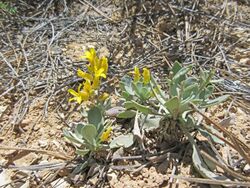Biology:Physaria lepidota
| Physaria lepidota | |
|---|---|

| |
| Scientific classification | |
| Kingdom: | Plantae |
| Clade: | Tracheophytes |
| Clade: | Angiosperms |
| Clade: | Eudicots |
| Clade: | Rosids |
| Order: | Brassicales |
| Family: | Brassicaceae |
| Genus: | Physaria |
| Species: | P. lepidota
|
| Binomial name | |
| Physaria lepidota Rollins
| |
| Synonyms[1] | |
|
(for subsp. membranacea)
| |
Physaria lepidota, the Kane County twinpod, is a plant species endemic to Utah. It is known only from Kane, Washington, and Garfield Counties in the southern part of the state.[2] It grows on rocky slopes and outcrops, and sometimes in disturbed areas.[3]
Physaria lepidota is a perennial herb with most of the above-ground parts covered with a silvery pubescence. Stems branch at the base but rarely above, sometimes reaching a height of 20 cm (8 inches). Flowers are yellow, born in a dense raceme. Fruits are highly inflated, up to 20 mm (0.8 inches) across with purplish papery walls.[4][5]
Subspecies
Despite the limited range of the species, two subspecies are generally recognized, differing in the shapes of the fruits and of the hairs in the pubescence:[6][7]
Physaria lepidota subsp. lepidota
and
Physaria lepidota subsp. membranacea
The two subspecies also differ in chromosome number (2n=16 for subsp. lepidota, 2n=8 for subsp. membranacea).[3]
References
- ↑ The Plant List
- ↑ USDA Plant Resources Conservation Service, Plants Profile
- ↑ 3.0 3.1 Flora of North America v 7 p 648.
- ↑ Rollins, R. C. 1981. Studies in the genus Physaria (Cruciferae). Brittonia 33(3): 332–341.
- ↑ Holmgren, N. H., P. K. Holmgren & A.J. Cronquist. 2005. Vascular plants of the intermountain west, U.S.A., subclass Dilleniidae. 2(B): 1–488. In A.J. Cronquist, A. H. Holmgren, N. H. Holmgren, J. L. Reveal & P. K. Holmgren (eds.) Intermountain Flora. Hafner Publishing Co., New York.
- ↑ O'Kane, Steve Lawrence. Novon 17(4): 531. 2007.
- ↑ Rollins, Reed Clark. Studies in the genus Physaria (Cruciferae). Brittonia 33(3): 338. 1981.
Wikidata ☰ Q16988058 entry
 |

